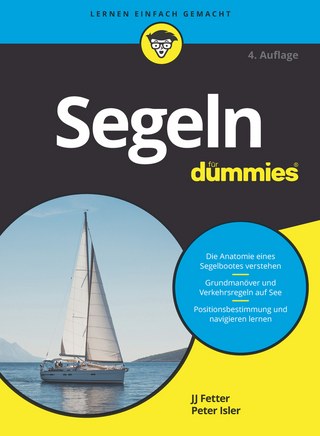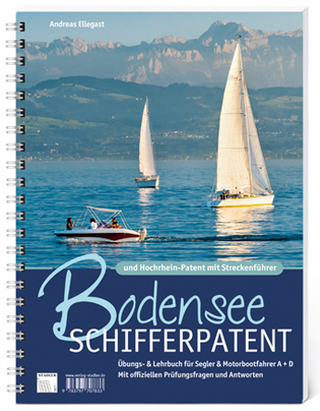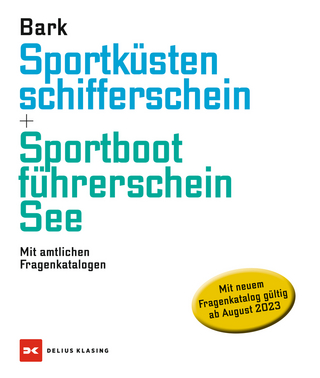
Adapted Aquatics Programming
Human Kinetics (Verlag)
978-0-7360-5730-1 (ISBN)
The second edition of Adapted Aquatics Programming: A Professional Guide
-clarifies rationales for adapted aquatics programming,
-broadens the scope of and enriches traditional programs for people with disabilities,
-guides instructors in improving teaching methods and safety management, and
-educates professionals on providing safe and effective adapted aquatics programs.
The second edition of Adapted Aquatics Programming: A Professional Guide is packed with new material, including up-to-date information on relevant legislation, guidelines on architectural accessibility, instructional strategies, equipment, safety management, and competitive and recreational aquatics activities.
This comprehensive resource is a significant addition to the aquatics literature, providing a practical learning tool for the field. The authors infuse each chapter with specific techniques as well as rationales for adapted aquatics programming. They also provide readers with
-best practices in adapted aquatics programming,
-a description of the scope of traditional adapted programs with enrichment ideas,
-guidance in improving teaching methods and safety management, and
-instruction in providing safe and effective adapted aquatics programs.
Adapted Aquatics Programming, Second Edition, contains a wealth of references, practical tips, and safety precautions. It includes a number of new features, including photographs and diagrams, life-experience scenarios that provide a reference point for the chapter ahead, and an objectives list for each chapter. It also offers ideas for using equipment and includes information about competitive and recreational aquatics activities.
In part I, the authors explore foundational issues of adapted aquatics, including models of collaboration, inclusion, planning, program development, facilities, equipment, and supplies. In part II they lay out instructional strategies and detail how to build safe and effective programs. They also look at the specific needs of program participants and issues related to aquatic fitness and rehabilitation. In part III they provide information on enhancing a program conducting competitive and recreational activities.
Founded on action-based research and current thinking, laws, and practices, Adapted Aquatics Programming, Second Edition, offers a practical approach to adapted aquatics, providing much-needed information on adapting the environment, equipment, instructional strategies, skill techniques, and teaching methods for people with disabilities. This text fills the need for a source of current best practices in adapted aquatics programming.
Monica Lepore, EdD, is a professor at West Chester University of Pennsylvania in West Chester. A master teacher of adapted aquatics, Dr. Lepore has been an American Red Cross water safety instructor for more than 25 years. She has a degree in leadership in adapted physical education and was a recipient of the International Swimming Hall of Fame Adapted Aquatics Award in 2001. In 2006 she was named AAHPERD/AAPAR Adapted Physical Education Professional of the Year, and she has been on the Top 100 Aquatics Professionals list twice. She acted as chair for AAHPERD/AAPAR adapted aquatics from 2000 to 2005 and received a Meritorious Award from the Aquatic Council of AAHPERD/AAPAR in 2005. In her leisure time, Dr. Lepore enjoys swimming, biking, and hiking. G. William Gayle, PhD, CAPE, is a professor and coordinator of adapted physical education at Wright State University in Dayton, Ohio. A master teacher of adapted aquatics, Dr. Gayle has been an American Red Cross water safety instructor for over 20 years. He holds degrees from Virginia Tech and University of Wisconsin at LaCrosse and a doctorate in adapted physical education and psychology of mental retardation and developmental disabilities from Ohio State University. In 1988 he was inducted into the Ohio Wheelchair Sports Hall of Fame. He served on the AAHPERD/AAPAR adapted aquatics committee from 2000 to 2005. In 2006 he was inducted into the National Wheelchair Basketball Association Intercollegiate Division Hall of Fame and selected as Teacher of the Year in the College of Education and Human Services at Wright State University. He has provided adapted aquatics programs for university students and surrounding school districts for several decades. In his leisure time, he enjoys golfing, swimming, and traveling internationally. Shawn F. Stevens, EdD, is executive director of Edgemoor Community Center in Wilmington, Delaware. Dr. Stevens has been an American Red Cross instructor trainer for water safety, lifeguarding, first aid, CPR, and AED for 25 years, and he was an adapted aquatics instructor trainer for 18 years. Overall, he has provided leadership in conducting aquatics programs for 30 years, and he assisted with the development of the ADA Accommodation Resource Guide for the American Red Cross. In his spare time, he serves as a volunteer instructor trainer and leadership volunteer for the American Red Cross, and he also enjoys golfing and swimming.
Preface
Acknowledgments
Part I. Foundations of Adapted Aquatics
Chapter 1. Introduction to Adapted Aquatics
Evolution of Adapted Aquatics
Legislation for Individuals With Disabilities
Benefits of Aquatics Participation
Applications of Aquatics Participation
Summary
Chapter 1 Review
Chapter 2. Models of Collaboration in Adapted Aquatics
Models for Adapted Aquatics
Medical-Therapeutic Model
Educational Model
Recreation Model
Transdisciplinary Model
Summary
Chapter 2 Review
Chapter 3. Inclusion and the Least-Restrictive Environment
Placement, Inclusion, and the LRE
Continuum of Placements
Prerequisites to Successful Inclusion
Developing and Maintaining Successful Inclusion Groups
Using Activities to Facilitate Inclusion
Summary
Chapter 3 Review
Chapter 4. Individualized Instructional Planning
Planning for Assessment
Developing the IEP or IAPP
Implementing the IEP or IAPP
Summary
Chapter 4 Review
Chapter 5. Program and Organization Development
Organizational Foundations
Communications and Promotion
Financial Development
Facilities Acquisition
Risk Management
Program Development and Evaluation
Human Resource Management
Summary
Chapter 5 Review
Chapter 6. Facilities, Equipment, and Supplies
Facilities
Equipment and Supplies
Summary
Chapter 6 Review
Part II. Facilitating Instruction
Chapter 7. Prerequisites to Safe, Successful, and Rewarding Programs
Essential Communication Skills
Transferring Techniques
Participant Care and Safety
Hydrodynamics
Positioning and Supporting Participants
Summary
Chapter 7 Review
Chapter 8. Instructional Strategies
The Learning Process
Teaching, Facilitating, and Guiding Participants
Addressing Problem Behaviors
Summary
Chapter 8 Review
Chapter 9. Specific Needs of Adapted Aquatics Participants
Definitions of Common Disabilities in Adapted Aquatics
Commonly Seen Attributes of Learners in Adapted Aquatics
Atlantoaxial Instability
Attention Deficit
Auditory Perception Disorder
Autonomic Dysreflexia or Hyperreflexia
Balance Disorder
Brittle Bones
Cardiovascular Disorder
Circulatory Disorder
Contractures and Limitations to Range of Motion
Hearing Loss: Deafness and Hard of Hearing
Hearing Loss: Deafblindness
Head Control Difficulty
High Muscle Tone
Hyperactivity
Interaction Difficulty
Joint Dysfunction
Kinesthetic System Disorder
Memory and Understanding Difficulty
Multisensory Loss
Oral Motor Dysfunction
Paralysis, Paresis, and Atrophy
Posture Disorder
Primitive Reflex Retention
Proprioceptive Disorder
Range of Motion Dysfunction
Receptive or Expressive Language Disorder
Respiratory Disorder
Seizure Disorder
Tactile System Disorder
Temperature Regulation Disorder
Vestibular System Disorder
Visual Impairment
Visual Perception Disorder
Summary
Chapter 9 Review
Chapter 10. Aquatic Fitness and Rehabilitation
Health-Related Physical Fitness and Aquatic Exercise
Physical Conditions and Tips for Aquatic Rehabilitation
Summary
Chapter 10 Review
Part III. Program Enhancement
Chapter 11. Adapted Aquatics Program Selection
Program Environments
Program Purpose
Types of Participation
Nationally Sponsored Adapted Aquatics Programs
Summary
Chapter 11 Review
Chapter 12. Competitive and Recreational Activities
Effect of Legislation on Aquatics Participation
Competitive Swimming for Individuals With Disabilities
Equitable Competition and Classification
Coaching Swimmers With Disabilities
Recreational Aquatic Activities
Summary
Chapter 12 Review
Appendix A Adapted Aquatics Position Paper of the Aquatic Council: AAALF and AAHPERD
Appendix B Assessment Forms
Appendix C Games and Activities for Various Age Groups
Appendix D Information-Gathering Forms
Appendix E Adapted Aquatics Program Resources
Appendix F AAPAR Levels of Adapted Aquatics Credentials
Glossary
References
Index
About the Authors
| Verlagsort | Champaign, IL |
|---|---|
| Sprache | englisch |
| Maße | 216 x 279 mm |
| Gewicht | 1202 g |
| Themenwelt | Sachbuch/Ratgeber ► Sport ► Segeln / Tauchen / Wassersport |
| ISBN-10 | 0-7360-5730-7 / 0736057307 |
| ISBN-13 | 978-0-7360-5730-1 / 9780736057301 |
| Zustand | Neuware |
| Haben Sie eine Frage zum Produkt? |
aus dem Bereich


